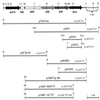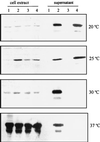Identification of the tliDEF ABC transporter specific for lipase in Pseudomonas fluorescens SIK W1
- PMID: 10074078
- PMCID: PMC93584
- DOI: 10.1128/JB.181.6.1847-1852.1999
Identification of the tliDEF ABC transporter specific for lipase in Pseudomonas fluorescens SIK W1
Abstract
Pseudomonas fluorescens, a gram-negative psychrotrophic bacterium, secretes a thermostable lipase into the extracellular medium. In our previous study, the lipase of P. fluorescens SIK W1 was cloned and expressed in Escherichia coli, but it accumulated as inactive inclusion bodies. Amino acid sequence analysis of the lipase revealed a potential C-terminal targeting sequence recognized by the ATP-binding cassette (ABC) transporter. The genetic loci around the lipase gene were searched, and a secretory gene was identified. Nucleotide sequencing of an 8.5-kb DNA fragment revealed three components of the ABC transporter, tliD, tliE, and tliF, upstream of the lipase gene, tliA. In addition, genes encoding a protease and a protease inhibitor were located upstream of tliDEF. tliDEF showed high similarity to ABC transporters of Pseudomonas aeruginosa alkaline protease, Erwinia chrysanthemi protease, Serratia marcescens lipase, and Pseudomonas fluorescens CY091 protease. tliDEF and the lipase structural gene in a single operon were sufficient for E. coli cells to secrete the lipase. In addition, E. coli harboring the lipase gene secreted the lipase by complementation of tliDEF in a different plasmid. The ABC transporter of P. fluorescens was optimally functional at 20 and 25 degrees C, while the ABC transporter, aprD, aprE, and aprF, of P. aeruginosa secreted the lipase irrespective of temperature between 20 and 37 degrees C. These results demonstrated that the lipase is secreted by the P. fluorescens SIK W1 ABC transporter, which is organized as an operon with tliA, and that its secretory function is temperature dependent.
Figures



References
-
- Ahn J H, Lee Y P, Rhee J S. Investigation of refolding condition for Pseudomonas fluorescens lipase by response surface methodology. J Biotechnol. 1997;54:151–160. - PubMed
-
- Akrim M, Bally M, Ball G, Tommassen J, Teerink H, Filloux A, Lazdunski A. Xcp-mediated protein secretion in Pseudomonas aeruginosa: identification of two additional genes and evidence for regulation of xcp gene expression. Mol Microbiol. 1993;10:431–443. - PubMed
-
- Altschul S F, Gish W, Miller W, Myers E W, Lipman D J. Basic local alignment search tool. J Mol Biol. 1990;215:403–410. - PubMed
MeSH terms
Substances
Associated data
- Actions
LinkOut - more resources
Full Text Sources
Other Literature Sources
Miscellaneous

